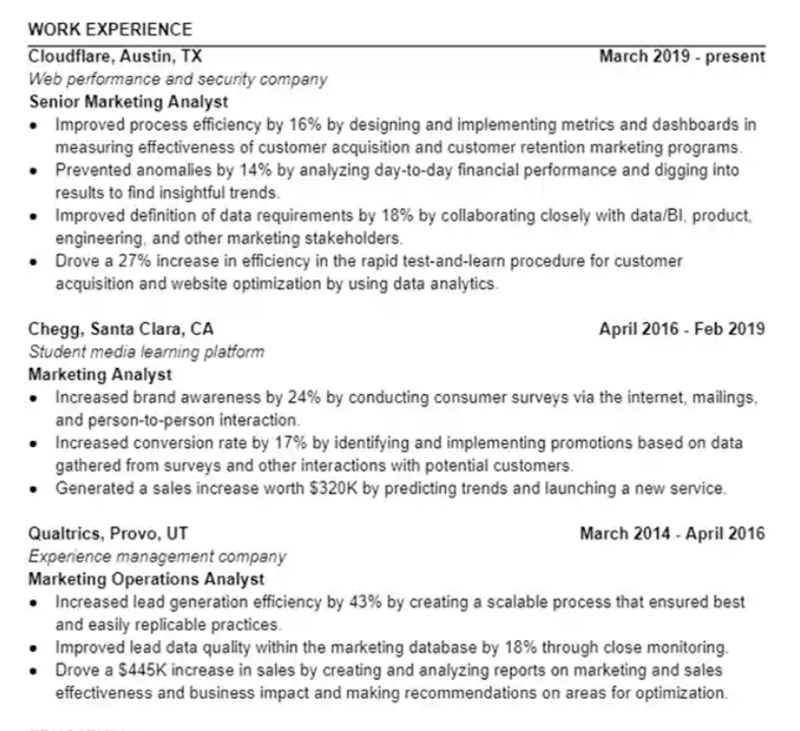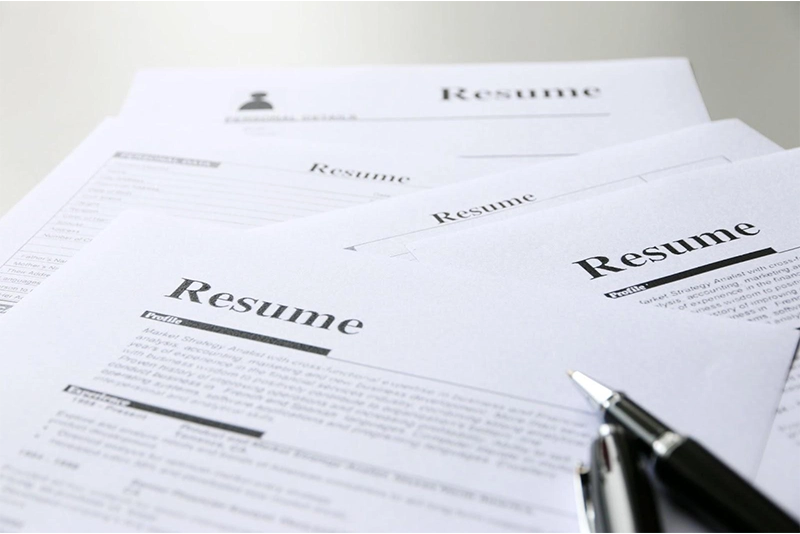If you’ve been in your career for fewer than 10 years, your resume should be one page. If you’re more than 10 years into your career, you can use two pages. However, professionals with more than a decade of experience often choose to keep their resumes to only one page.
Recruiters spend an average of 7.4 seconds reading a resume before deciding whether to move forward with a candidate, so it’s essential that you keep your resume simple and clear.
In this article, we’ll look at how you can efficiently format your professional summary, work history, and all other relevant information onto the appropriate number of pages for where you are in your career.
Let’s dive right in.
How to format your resume for the right number of pages
While there is a debate in the professional community about how many pages a resume should be, Robert H. Ruff, Co-Founder and President of Sovren, said it best: “The cure for a bad resume is to tell less, more powerfully.”
If you’ve been in your career for less than a decade, one page is plenty to show your four audiences — screener, recruiter, future boss, and applicant tracking system (ATS) system — if you’re the right candidate for the job.
Let’s go through your resume section by section and discuss how you can efficiently include all important information while keeping it simple and easy to read.
Contact information
Your contact information needs to appear at the top of your resume. It should include your first and last name, email address, street address, and phone number.

The parser searches for this information to confirm that they’re looking at a resume and starting in the right place. You should place it at the top of your resume, before any sections, headers, or anything else.
Doing this puts the data in the right order so the parser can start sorting it right away.
Whether you’re looking for a job that’s within biking distance from your house or in a different state, your current city, state, and postal code are important. Recruiters looking for candidates from a larger geographical area usually search by location. Using your contact information as a de-facto header will make your resume more visible to them.
Professional Summary
Traditionally, candidates have included an “objective” section early in their resume, but an objective is not the most effective way to convey your intentions.
Instead, write a professional summary.

Your professional summary and professional headline should take up only about 10% of the page, but you should put most of your resume-writing effort into getting it just right.
It defines who you are as a professional, sums up your career to this point, and tells your four audiences the next step you intend to take in your career.
Your professional summary should be centered, not left justified, and be three or four lines. It should begin with a professional headline, which is a title paired with a strong adjective that tells recruiters who you are as a candidate.
The first line lists possible job titles for your next position, the second line lists your professional qualities, skills, and abilities, the third line lists important skills and achievements in your recent career, and the optional fourth line lists additional skills and achievements you believe bring value to your professional pitch.
If you have a single item alone at the bottom, simplify your wording until it disappears or remove something from any of the previous lines.
Make sure there’s no fluff and everything in your summary is a genuine value proposition. The professional summary is meant to be the primary pitch of your professional capabilities. It should stand out from not only the other candidates, but also from the rest of your resume.
The more compelling your professional summary is, the better it will convey your goals and expectations regarding the position you’re applying for.
Never “cheat” by shrinking your font size. The recruiter’s eyes should be able to scan your resume quickly — without the aid of a magnifying glass. The point of your professional summary is to be a deliberately short section that delivers the most impact.
Using a tiny font and packing in tons of information defeats the entire purpose.
Professional history
This section should be the bulk of your resume, as it’s where you’ll likely have the most information to cover. Your work history should be listed in descending order, with your current or most recent job first. And it should be formatted with bullet points.
If you have more than 10 years of experience and are writing a two-page resume, you can use 25 bullet points. If you haven’t completed the first decade of your career, aim for 10-15 bullet points on a single page.

Any work history that’s more than 15 years old should be left off of your resume. While you may be proud of a position you had earlier in your career, even if it was prestigious or at a famous company, it has little relevance today as it doesn’t tell the recruiter anything about your current capabilities as a professional.
Your most recent jobs should come first in the list of your professional history. In most cases, your current or most recent position is most relevant to the job you’re applying for today, and recruiters want to know what you’re currently capable of professionally.

Make the most of each bullet point by including success verbs and numerical values like percentages and dollar amounts, so you can quantify your successes and highlight them in a tangible way.
Each bullet point should read like an achievement or “high score.” You want to show recruiters and anyone else reading your resume that you get results and generate actual change instead of just going through the motions.

This method shows proven results instead of empty claims, and this entices recruiters and potential interviewers. While you may have achieved difficult and impressive things in your career, the primary thing recruiters and hiring managers are looking for is what you can do for your future employer. Dollars and percentages give them an idea of the kind of success you can duplicate for them.
If there’s a gap in your professional tenure, you’ll need to be transparent (and careful) about it in this section.
While every recruiter should understand COVID-related gaps, if you’ve paused your career due to being fired, retiring, raising children, or any other reason, show these in the best possible light.
While a gap of more than 12 months will never look good on a resume, you can minimize the impact of the gap and show your enthusiasm for returning to work. For example, “Temporarily disabled due to injury, excited to return to work” or “Fortunate to raise four children, energized to focus on my professional career.” Regardless, be brief and crisp, and move on to the next point.
Mention any social volunteering, nonprofit work, or consulting roles you had while taking time off from your career. This will show you stayed active during the gap.
NOTE: If a past employer was involved in a scandal or legal issue, address it head-on. Mention the controversy along with a disclaimer that tells how you or your division were not involved in any of the wrongdoings, or what you’ve learned and how you’ve grown since then. Don’t assume future employers will blacklist you due to association with notorious companies. In some cases they’ll be intrigued.
Tips for keeping your resume brief but effective
Since you only get a few seconds of the recruiter’s time, here are some ways you can make the most of it.
1. Be clear and concise
Write shorter, more impactful phrases that “show” instead of “tell.” Include only the most meaningful details of your professional life in a way that proves your value to your future employer.
More than anything, be as clear and concise as you can with the details to help resume parsers pick up data easily. According to Ninh Tran, a founding member of Hiretual, “When it comes to resume parsers … stay away from fancy resumes.”
The more simple and straightforward the resume is, the better.
A clear and concise resume helps human audiences also. It allows them to look through your resume faster and absorb all the relevant information. Remember, recruiters spend only a few seconds looking at each resume. Irrelevant information slows them down and makes it less likely they’ll catch the details they most need to see.
2. Mention relevant details
Don’t include anything that isn’t directly relevant to the position you’re applying for.
Both the hiring manager and your future boss don’t want to know about that internship or part-time gig you had 10 years ago that’s completely unrelated to the positions you’re applying for today. That doesn’t tell them anything about your current professional abilities.
Instead, list the jobs that are most relevant to your current career path.
For example, if you’re looking for a senior managerial or executive position, you’re currently a junior manager, and you were a team lead before that, mention all of those so your work history section shows a cohesive career path.
Highlight the important decisions or changes you made during your tenure at each position. If there were some large-scale changes within the organization that challenged your position but you managed to keep things steady, mention those as well.
3. Use job-specific keywords
Resume parsers and other software systems pick up on keywords spread throughout your resume. Keywords help them index your resume correctly and allow recruiters to find it through a simple keyword search. While it may seem beneficial to include as many keywords as you can, keyword-stuffing your resume can sink your chances of getting an interview.
You should repeat the most important keywords a few times in places where they feel natural, as parsers rank resumes according to how many times a keyword occurs in the text. But AI can understand the context around the keyword. This means that if the keyword is in a section where it doesn’t belong, your resume may get ranked much lower.
And even if a keyword-stuffed resume gets past an ATS, a human audience always stands between you and a job interview. Packing your resume full of popular but irrelevant keywords may cause recruiters to keep seeing your resume for different, unrelated job postings. If they realize you’re trying to game the system, they'll ignore your resume or delete it altogether.
A recruiter or hiring manager, if not the parser, will notice keywords that are irrelevant or shoehorned into awkward places. Make sure all keywords appear organically, and that your resume reads naturally for humans as well as robots.
4. List actual returns as achievements
Instead of taking up space with awards and accolades, focus on your work achievements. These can include things like how much ROI your work generated, the number of people you onboarded on to a new system, or how many accounts generated profit.
Using returns as achievements tells recruiters two things:
- You know what they’re looking for.
- Your resume is worth forwarding to the higher-ups.
It also tells your future boss two things:
- You’re serious about demonstrating your successes.
- You’re passionate about getting meaningful results.
Numbers are easier to understand than words, and they convey much more relevant information. For example, saying “Generated 5X higher returns per campaign” tells them more than something vague like “Got higher returns for each campaign than all previous campaigns.”
Without a numerical value as an indicator of success, your audience has no way to quantify the returns.
5. Never include images
Resume parsers are designed to scan the text of a resume and display it in a format the recruiter wants. The parser will ignore headshots completely, which means they’re a waste of space, and images like charts and graphs make processing your data much more complex for the parser to process.
For example, the parser may skip a section that immediately follows an image. This may cause it to miss important details. Likewise, never submit a PDF or scan or your resume, as these aren’t text formats. Instead, submit your resume as a Microsoft Word document, Google Doc, or other text-based format.
Avoid fancy formatting and keep your resume simple, even if you’re in a creative field and you feel a “boring” resume doesn’t reflect who you are.
Remember, the resume itself is not supposed to be a visual representation of your skills. It’s simply a document with written details about you. The visual demonstration comes much later, if and when you’re called in for an interview.
Create a winning resume
If you want to land a job interview, keep your resume short, simple, concise so your biggest successes stand out. Use one page if you’re in the first decade of your career. A second page is optional if you have 10 or more years of relevant work history.
By following these rules and optimizing for AI, you can make yourself more appealing as a candidate and help your resume show up higher in searches.
Ready to get started on your winning resume? We can help!







